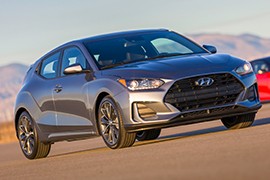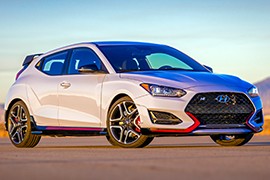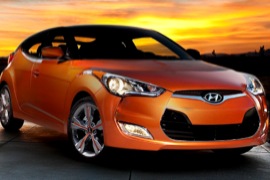HYUNDAI Veloster Models/Series Timeline, Specifications & Photos
First production year: 2011
Engines: Gasoline
Body style: Coupé (two-door)
The second generation Hyundai Veloster came out in 2018 featuring a new design and a fresh interior along with better engines and more features.
Much of the redesign is derived from enhanced proportions and volume; the new shape clearly conveys focused dynamic performance, even standing still. Its stance is more muscular, with higher-volume fenders and wheel arches for a more planted appearance. The cowl point and A-pillar are further rearward and now connect the hood line and belt line into an integrated, powerful gesture. The asymmetrical design carries through to the interior, with a driver-focused interior layout and on the Turbo Ultimate, a contrasting color environment that visually separates the driving cockpit. Each trim level has unique colors, materials, and accents, further differentiating each model with varying hues and textures.
The level of standard safety features was exceptional, as the Velosters were offered with a Vehicle Stability Management, ESC, and Motor Driven Power Steering. The car was equipped with 6 airbags and a magnificent braking package including four-wheel disc brakes and ABS with brake assist (applies maximum braking force in case of emergency detected) and EBD which automatically adjusted the braking force to the front and the rear axles depending on the loading conditions.
The colors available for the Velosters were Ultra Black, Chalk White, Sonic Silver, Thunder Gray, Sunset Orange, Racing Red and Space Gray.
When the Hyundai launched its N version for some of the models, it couldn't be left aside the Veloster, the only hatchback on the market with 3+1 doors: two on the curbside and one for the driver.
Hyundai Veloster N was shown to the public in 2018 at the North American International Auto Show as a 2019 model. It kept the same 3+1 door concept that made it unique. But then, it added what the hot-hatch look it needs: a proper engine.
When compared with the other Veloster versions, the N had something more to tell. The big, piano-black grille had the little "N" red badge on it. There were specific air-ducts to cool the brakes were part of the image. From the side, the specific 18" light-alloy-wheels were fitted with 225/40R18 tires and an option for a 19" set with 235/35R19. On top of the tailgate, there was a small wing installed on top of a roof spoiler. The officials said that both works in creating some downforce.
Inside the cabin, the three-door concept was good to take passengers in the rear. But the main features were for the driver. It included a shift-light indicator on the dashboard, to warn and prepare when to up-shift. For the downshift, a rev-match system was offered. The Infinity sound system that equips the Veloster N was part of the infotainment unit with an 8" touch-screen display.
For the technical department, the Veloster N had few options on top of its 275 hp engine. While the transmission was a 6-speed manual only, it was available with an electronically controlled limited-slip differential, to handle the power better.
Hyundai introduced the Veloster as an alternative for the hot-hatch market in 2011 and built the vehicle on top of the same platform used for the Accent and the i20.
Carmakers are experimenting with new types of vehicles in their quest to find new market opportunities. Some of them are going hits, such as the SUV-coupe shapes, while some are going bust, such as the coupe-MPVs. Also, sometimes a vehicle's success depends on the timing when it comes to the market. For example, Hyundai looked like it marked a good moment in 2011 to show their Veloster, and it was a unique-looking hatchback.
While most hatchbacks featured three or five doors, including the tailgate, the Veloster offered four. It had two doors on the driver's side and one on the passenger's side. The vehicle's sporty look was amplified by the sloped roofline ending into a raked-forward rear windscreen. Since it had two doors on the curb's side, the rear occupants couldn't exit on the side of the car where the traffic was. That was a relief for parents who had their kids in the back.
Inside, the design team installed a dashboard resembling the i30 but with a V-shaped center stack. The letter came, obviously, from the Veloster. The bucket seats provided high bolstering, thus creating better side support for their occupants. In the back, the sloped roof provided minimal headroom for full-grown adults but was just fine for children. Also, it was better than in a regular coupe or in the Tiburon that the Veloster replaced.
Under the hood, the automaker squeezed a 1.6-liter, turbocharged engine. In addition, the powerplant proved to be very fuel efficient thanks to its direct fuel-injected system.


